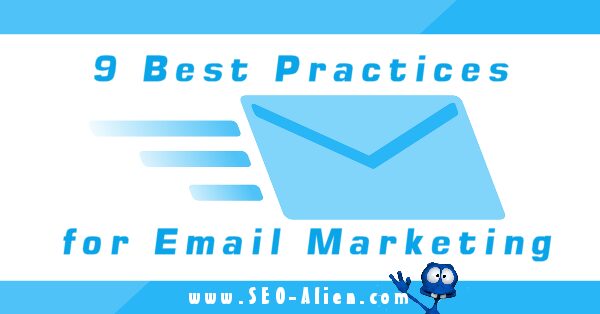Sixty-nine percent of adult consumers say they have been influenced to make purchases based on branded emails, according to Marketing Sherpa.
To help every email marketer – no matter what your experience level – Campaign Monitor offers these nine best practices to follow for email marketing. These best practices will give you a good baseline for a strategic approach to email.
1. Send Personalized Messages
Using the recipient’s name in the subject line can be very effective. Results prove it. Personalized subject lines provided a 22% increase in unique open rates, a 27% greater unique click rate, and more than double the transaction rates of other promotional mailings from the same brands, according to research by Experian.
You can personalize your messages far beyond adding a first name, however. Depending what product or service is being sold, marketers can insert the name of the recipient’s vehicle, pet, spouse, or other relative. For example: “Don’t forget Jill this Valentine’s Day!”
Mentioning a previous purchase to request feedback or make a suggestion for an upgrade or complementary product can also help build trust with customers.
2. Segment Your Contacts
Dividing up email contacts by groups like gender, location, interests, behavior, age and marital status can help marketers send personalized, targeted messages. Create segments that make sense for your company, and plan to send different emails to each group.
This gives you the ability to send more relevant messages to subscribers. A clothing store, for instance, can segment their list by gender and send women emails containing images of women’s clothing, while men receive images of menswear.
You can also segment email contacts further by breaking the females down by age, so that teenagers get a different email than 50-year-old women.
Creating emails for each group does take time and effort, but 51% of marketing influencers say list segmentation is the most effective email marketing strategy, according to a survey by Ascend2.
3. Use Dynamic Content
Dynamic content gives you the ability to create one email campaign, but dynamically change certain elements to fit each subscriber
Content that is specific to the recipient can help you build trust and increase sales. How much? Relevant emails drive 18 times more revenue than broadcast emails, according to JupiterResearch.
For example, if you sell sporting equipment and plan to have a holiday sale, you can create an email that promotes the sale and offers a 20% off coupon, but based on a subscriber’s location the images change so the customers in Dallas see Cowboy merchandise while the subscribers in Pittsburgh see Steeler gear.
4. Leverage Automation
Since customers demand a personalized touch, it can be tough to create and send emails to keep up with demand. Automation can help. You can create emails ahead of time and trigger them to send based on a specific time or behavior.
When a subscriber visits your website and browses an online class that you offer, for example, that action can trigger a follow up email that reminds him or her to sign up.
You can use automation to guide consumers through their shopping journey too. When a customer signs up for your email you can create a three-email series that helps the customer learn about your business and product.
Once you’ve embraced automation, you’ll see rewards. Companies using marketing automation see 53% higher conversion rates, according to the Aberdeen Group.
5. Create an Effective Call to Action (CTA)
Once marketers determine what it is they want the recipient to do– such as download a report, start a free trial, buy something or refer a friend– they can create a call to action to persuade the consumer to do it.
A good call to action will use concise language with action words like “Buy Now” or “Claim Your Deal Today.” Many marketers find that button-based CTAs increase their click-through rates over link-based CTAs since they’re more eye-catching
6. Collect Data from Your Customers
The more you know your customers, the better your marketing tactics. It’s important to collect information, but don’t try to collect it all at once.
Get the basics at sign up, then gradually gather more pieces throughout the customer’s journey. You can send out a survey, encourage subscribers to share their interests with you via a preference center, or collect specific when a subscriber downloads a paper.
These data points will drive most of your other marketing practices, including automation, segmentation, personalization, promotions and calls to action.
7. Test your Emails
Smart marketers experiment with different language, colors, images, and button placement then measure results and compare.
Sometimes, simply enlarging the size of a CTA button can make a big difference to get mobile phone users to act on an offer.
Try sending campaigns at different times of day or night, on different days and with different subject lines. Measure results and learn from them; the data is gold for future marketing efforts.
Word of caution though, test one thing at a time so you know what’s working.
8. Design for Mobile
Long gone are the days where marketers could simply send out a one-size-fits-all email with the expectation that everyone would be sitting at their desktop computer to view it.
Today’s consumers use a variety of devices, so an email has to look sharp on every device.
For starters, use an email service provider that has premade templates with a responsive design, which allows the email to adapt to any device it’s opened on.
You should also keep text blocks short, use bullet points to keep your emails organized, and make sure your CTA is large enough for a thumb-tap.
By 2018, 80% of email users will access their email accounts via a mobile device, predicts Small Biz Trends, so focusing on mobile design elements now is crucial.
9. Offer a Promotion
Who can resist a good deal? That’s why so many emails contain a promotion. Campaigns used to drive sales often include promotions in the form of discounts on products or services, free samples, limited edition products or VIP offerings.
Explain what the discount is and how to use it, add images of products, and a clear call to action that subscribers are drawn to.
More Help?
Looking for help implementing these nine best practices for email marketing, Send emails your customers can’t ignore.See why 200,000 companies worldwide love Campaign Monitor
About the Author:
The SEO-Alien is a project started in 2009 regarding all things online marketing. The site started out more of a diary of predictions, suggestions and references to things I frequently used for online marketing... before social media marketing was even an option.
I hope you find the information and tools presented here useful and something worth sharing with others.
If there is anything else about online marketing or any online advertising strategy you think would be helpful, please let me know.



